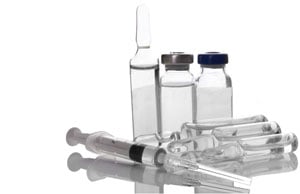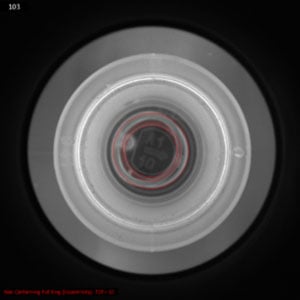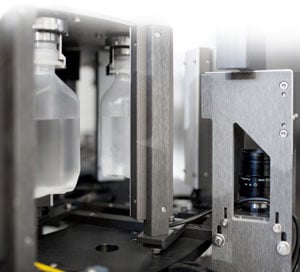Bonfiglioli Engineering Automatic Visual Inspection (AVI) machines quickly and reliably detect the presence of cosmetic or particulate defects in the packaging or contents of pharmaceutical products.
High-resolution cameras take still and moving images as items move along the production line. Bonfiglioli Engineering harnesses the power of Artificial Intelligence (AI), to further refine the visual inspection process, using neural networks to deliver increased quality control with speed and accuracy.
Automatic Visual Inspection: What is it and why is it useful for testing pharmaceutical products?
 Bonfiglioli Engineering uses neural networks to improve the performance of visual inspection machines significantly. Neural networks allow Automatic Visual Inspection machines to refine their performance through continuous training (machine learning), so they become increasingly accurate and reliable over time. What makes these machines different is their ability to analyze the images collected by the cameras in a flexible manner, using a very large data set and not an algorithm based on defined characteristics. This allows the machine to independently calibrate the parameters it uses to provide the result and to adapt its process of analysis to the properties of each product being tested.
Bonfiglioli Engineering uses neural networks to improve the performance of visual inspection machines significantly. Neural networks allow Automatic Visual Inspection machines to refine their performance through continuous training (machine learning), so they become increasingly accurate and reliable over time. What makes these machines different is their ability to analyze the images collected by the cameras in a flexible manner, using a very large data set and not an algorithm based on defined characteristics. This allows the machine to independently calibrate the parameters it uses to provide the result and to adapt its process of analysis to the properties of each product being tested.
Automatic visual inspection offers many advantages:
-
Repeatability: When run under the same conditions, tests based on Automatic Visual Inspection always provide the same result. This means that the machine is more efficient than manual inspection, since humans are unable to maintain consistent attention, making them prone to mistakes.
-
Speed: The machine analyzing the images can provide results much more quickly than manual inspection. The speed depends on the type of product tested, but Bonfiglioli Engineering currently manufactures machines that can inspect up to 400 products per minute with the possibility of increasing this speed further, while a human operator works at the rate of 30 products per minute. In other cases, for very large products, Bonfiglioli Engineering machines can inspect 38 products per minute, compared to a speed of one product per minute for a human operator.
-
Consumer Safety: Thanks to the speed and non-destructive nature of Automatic Visual Inspection machine testing, a manufacturer’s entire production can be inspected with no need for sample testing increasing quality assurance and efficiency.
-
Reliability: The tests are extremely precise and can accurately classify products that would be registered with limited varieties if they were tested using only traditional visual inspection tools.
-
Proven accuracy and speed: The Knapp test shows that an Automatic Visual Inspection Machine provides more accurate results than manual testing. The performance of each of Bonfiglioli Engineering Automatic Visual Inspection machines is evaluated using a statistical methodology that compares their results with those of human operators. This is done using a batch of products with specific problems (Knapp test set) that is inspected both by the machine and manually. At the end of the test, the performance of the automated machine is compared with that of the human operators, to see whether the machine provides faster and more accurate results. The Knapp test is performed during both the Factory Acceptance Test and the Site Acceptance Test and is a fundamental parameter for customer acceptance of the Automatic Visual Inspection machine.
Bonfiglioli Engineering Automatic Visual Inspection machine performance
Automatic Visual Inspection machines offer countless advantages in terms of testing speed and accuracy. The main questions at this point are: how precise are these machines? Can they really detect even extremely small particles?
 Automatic Visual Inspection is based primarily on the use of two-dimensional cameras that, while not able to measure elements in a three-dimensional space, are still valuable statistical tools. Therefore, they cannot be used to determine the minimum size of the defect that the cameras are able to detect with certainty, because this parameter depends on a multitude of factors.
Automatic Visual Inspection is based primarily on the use of two-dimensional cameras that, while not able to measure elements in a three-dimensional space, are still valuable statistical tools. Therefore, they cannot be used to determine the minimum size of the defect that the cameras are able to detect with certainty, because this parameter depends on a multitude of factors.
While the minimum defect size detectable by the machine cannot be precisely defined, the degree of resolution that can be achieved can be determined, starting from the performance of the cameras capturing the product images.
Thanks to new developments of the technology, we know that if the product is placed in front of the camera in a level position and is photographed using a distortion-free lens, the image can have a resolution of less than 20 microns per pixel. Another useful element in determining the potential of these instruments is the performance achieved by some of Bonfiglioli Engineering Automatic Visual Inspection machines already installed at customer companies. In batches of liquid products contained in glass vials, these machines have identified particles with a certified size of 50 microns in diameter. This information provides an idea of the high level of precision that this technology can reach.
The main advantage of using this technology is not the possibility of identifying particularly small particles, but of identifying defects more precisely, reducing the need for operator training and preparation.
Automatic Visual Inspection for testing complex products
The performance, precision and speed of Automatic Visual Inspection are heavily influenced by the type of product and packaging being inspected.
Some products are generally better suited for inspection by human operators who, despite taking more time than the machine, can provide more precise results. A classic example of this is powdered product testing, which is done, where possible, by human operators who shake the product in every direction to detect the presence of any foreign bodies inside the packaging. However, even in the case of powdered products, for testing samples of 250 units or even entire production batches, the machine performance is more efficient and faster.
Other products, on the other hand, are particularly well suited to testing with Automatic Visual Inspection: these include vials or pre-filled syringes containing liquids, that are rather difficult for human operators to inspect. It is quite difficult for operators to spot small particles inside these products, but the machine can perform the test with great accuracy and precision. The neural network provides even better performance when analyzing vials containing cake: in this case, it can be difficult to detect some defects, like a deformation of the vial wall, when inspecting the product manually or using traditional Visual Inspection. Automatic Visual Inspection, on the other hand, can provide extremely precise results.
 Automatic Visual Inspection promises excellent performance for Blow-Fill-Seal (BFS) products as well. Testing on this type of packaging is technically complex because of their thermo-formed characteristics, but Bonfiglioli Engineering has developed considerable expertise in this field. Analyzing these products with Automatic Visual Inspection provides precise results, since neural network makes it possible to identify both the presence of particles and their behavior in space, significantly reducing inspection times. In fact, some particularly complex products can be inspected in a mere 1.3 seconds, compared to the 60 seconds required by human operators performing the same type of packaging integrity and particle inspection.
Automatic Visual Inspection promises excellent performance for Blow-Fill-Seal (BFS) products as well. Testing on this type of packaging is technically complex because of their thermo-formed characteristics, but Bonfiglioli Engineering has developed considerable expertise in this field. Analyzing these products with Automatic Visual Inspection provides precise results, since neural network makes it possible to identify both the presence of particles and their behavior in space, significantly reducing inspection times. In fact, some particularly complex products can be inspected in a mere 1.3 seconds, compared to the 60 seconds required by human operators performing the same type of packaging integrity and particle inspection.
Bonfiglioli Engineering is pushing the inspection industry forward by incorporating AI into the equipment. Contact us for more information on Automatic Visual Inspection for your packaging inspection needs.

